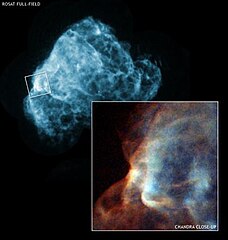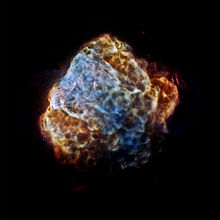Puppis A
 Pozostałość po supernowej Puppis A (zdjęcia z teleskopów ROSAT i Chandra) | |
| Odkrywca | Skylark |
|---|---|
| Data odkrycia | październik 1971 |
| Dane obserwacyjne (J2000) | |
| Gwiazdozbiór | |
| Typ | |
| Rektascensja | 08h 24m 07s[1] |
| Deklinacja | –42° 59′ 48″[1] |
| Odległość | 7000 ly |
| Rozmiary kątowe | 60×50'[1] |
| Charakterystyka fizyczna | |
| Wymiary | ∅ 100 ly[2] |
| Szacowany wiek | 3700 lat |
| Alternatywne oznaczenia | |
| G260.4-03.4, SNR 260.4-3.4, SNR PUP A | |
Puppis A (G260.4-3.4) – mgławica odległa o około 7000 lat świetlnych od Ziemi, będąca pozostałością po wybuchu supernowej, który wydarzył się około 3700 lat temu[a]. Została odkryta na zdjęciach pochodzących z rakiety sondażowej Skylark wykonanych w październiku 1971 roku.

Jej średnica szacowana jest na około 100 lat świetlnych, zaś rozmiar kątowy to 60×50’.
Z pozostałością związana jest gwiazda hiperprędkościowa znana nieoficjalnie jako „Kosmiczna kula armatnia” (Cosmic Cannonball) – RX J0822-4300.
Zobacz też
Uwagi
- ↑ Wydarzył się oznacza, że mógł być widziany z powierzchni Ziemi około 3700 lat temu, sam wybuch wydarzył się jeszcze 7000 lat wcześniej.
Przypisy
Linki zewnętrzne
Media użyte na tej stronie
Unprecedented X-ray View of Supernova Remains — The destructive results of a powerful supernova explosion reveal themselves in a delicate tapestry of X-ray light, as seen in this image from NASA’s Chandra X-Ray Observatory and the European Space Agency's XMM-Newton.
The image shows the remains of a supernova that would have been witnessed on Earth about 3,700 years ago. The remnant is called Puppis A, and is around 7,000 light years away and about 10 light years across. This image provides the most complete and detailed X-ray view of Puppis A ever obtained, made by combining a mosaic of different Chandra and XMM-Newton observations. Low-energy X-rays are shown in red, medium-energy X-rays are in green and high energy X-rays are colored blue.
These observations act as a probe of the gas surrounding Puppis A, known as the interstellar medium. The complex appearance of the remnant shows that Puppis A is expanding into an interstellar medium that probably has a knotty structure.
Supernova explosions forge the heavy elements that can provide the raw material from which future generations of stars and planets will form. Studying how supernova remnants expand into the galaxy and interact with other material provides critical clues into our own origins.
A paper describing these results was published in the July 2013 issue of Astronomy and Astrophysics and is available online. The first author is Gloria Dubner from the Instituto de Astronomía y Física del Espacio in Buenos Aires in Argentina.The Chandra three-color image (inset) of a region of the supernova remnant Puppis A (wide-angle view from ROSAT in blue) reveals a cloud being torn apart by a shock wave produced in a supernova explosion. This is the first X-ray identification of such a process in an advanced phase. In the inset, the blue vertical bar and the blue fuzzy ball or cap to the right show how the cloud has been spread out into an oval-shaped structure that is almost empty in the center. The Chandra data also provides information on the temperature in and around the cloud, with blue representing higher temperature gas. The oval structure strongly resembles those seen on much smaller size scales in experimental simulations of the interaction of supernova shock waves with dense interstellar clouds (see sequence of laboratory images). In these experiments, a strong shock wave sweeps over a vaporized copper ball that has a diameter roughly equal to a human hair. The cloud is compressed, and then expands in about 40 nanoseconds to form an oval bar and cap structure much like that seen in Puppis A.

